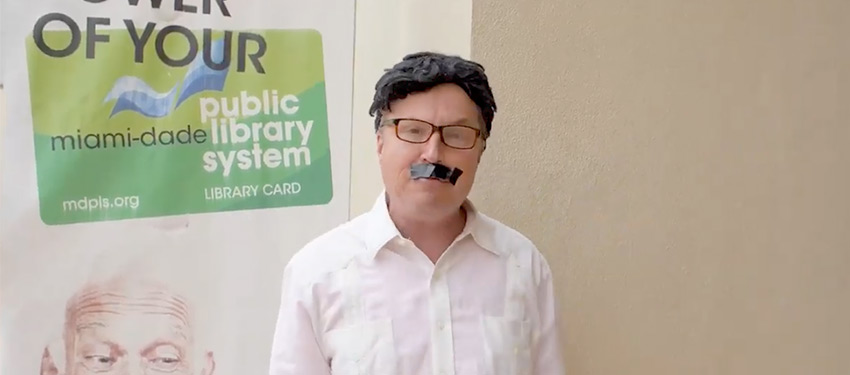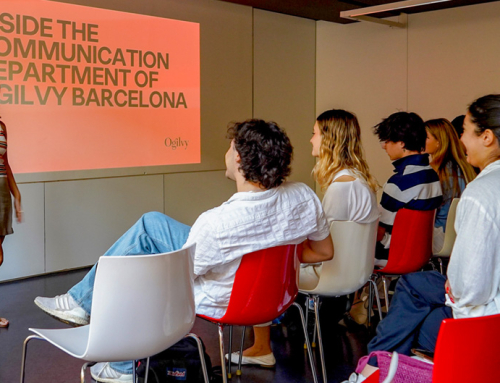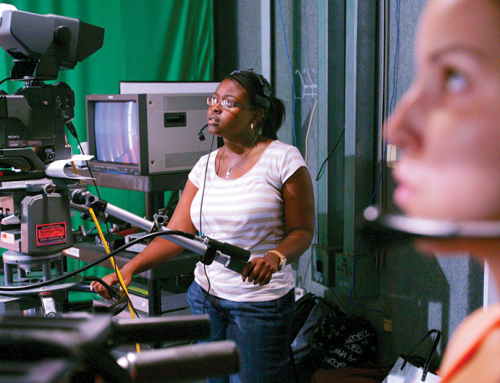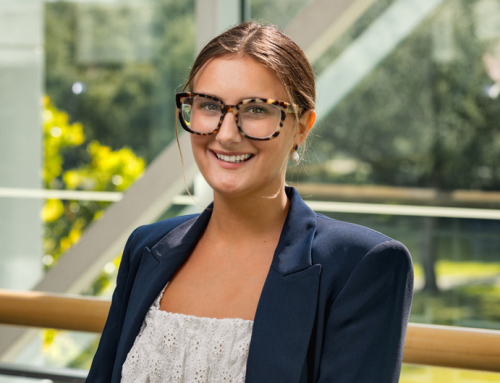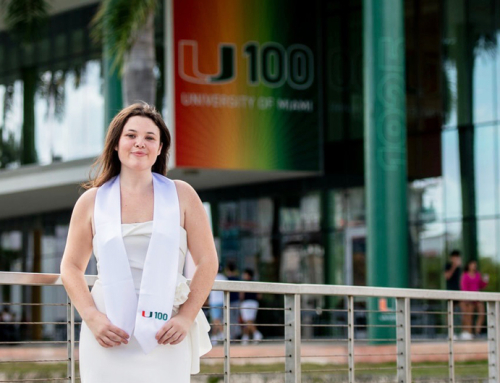Most wouldn’t expect a middle-aged man wearing a set of pastel-blue women’s scrubs, a floral scarf and a so-obviously fake wig to be prancing loudly around their public library, with a cameraman capturing his every move. But hey, this is Miami – anything’s possible.
Freddy Stebbins, B.S.C. ‘90, a UM alumnus, Miami Dade College sociology professor, and award-winning comedian, is the man in the scrubs, but he isn’t really a cross-dressing, library-disrupting, physician’s assistant. No, Stebbins, along with fellow UM alumni Ben Leis, B.S.C. ’04, and Andrew Schear, B.S.C. ’12, created something so outrageously funny and perfectly misplaced that is receiving lots of attention.
Laughter in the Library is a trio of short films in which Stebbins dresses up like three stereotypical Miamians and tells the history of The Magic City through their eyes. However, the project began when Leis, managing director of a comedy company called Comic Cure and producer of Laughter in the Library, became aware of a competition called the Miami Public Space Challenge, put on by the Miami Foundation.
Each year, the foundation invites the Miami community to creatively utilize different public areas that don’t normally get much attention. Leis’ inspiration for Laughter in the Library came from attending one of Stebinns’ walking history tours of Miami.
“We thought this would be a great idea if we took it to libraries around Miami Dade County and got people to think about libraries other than just books,” said Leis. “They’re actually places of experiential learning.”
Out of 500 submissions, Leis’ Laughter in the Library tour idea was one of 22 projects to be funded by the Public Space Challenge. And, thus, Stebbins, much to his delight, began playing hilarious characters across five Miami public libraries, eliciting peals of laughter from children and elders alike. But, it wasn’t until Leis approached Schear, a local video producer, to film and edit the series, that the dynamic, UM-lovin’ trio was born. Stebbins, Schear and Leis set out to create a video series that would promote the library tour.
“I feel that the series accurately portrays caricatures of some of the different types of people you meet in Miami,” said Schear. “Filming in a public space that’s rich with local history, with characters that are true to form, and adding some music that people think of when they think of Miami – it all gelled really nicely into a finished product we were very satisfied with.”
Stebbins decided on three of his caricatures to play in the video series – Lisette, “the Latina girl that we all know that works in every single medical clinic in South Florida,” Sol, “the old man character,” and Jose, “the old Cuban man who’s a know-it-all,” said Stebbins and Schear of the larger-than-life characters.
Though each character has his or her own witty quirks, Stebbins admits that Lisette is his favorite of the three.
“Lisette,” Stebbins gushed. “She’s the Hispanic girl who is still wearing her scrubs, who didn’t go to UM, but it has always been her dream to transfer to UM. And she’s very Miami, she loves South Florida, she’s going to the library to become more educated and sophisticated and that’s fine! Oh, and also to meet hot guys. I like her.”
Stebbins’ characters, which, outside of the series, include various stereotypes, are enough to make your sides hurt, to say the least. However, both Leis and Stebbins agree that the comedy can, sometimes, be borderline-offensive.
But Stebbins isn’t worried about offending anyone. The acclaimed character comedian, who studied at the Groundlings School, the most prestigious comedy training program in Los Angeles, said that it wasn’t his stereotypical accents, though they’re what he is known for, that was funny about the series – it was each character’s flaw, beyond their stereotypical Miami tendencies.
“The Cuban old man who’s a know-it-all – it’s not that he’s a Cuban old man – I mean that makes it a little funnier, but it’s that he’s a know-it-all,” said Stebbins. “Or for Lisette, it’s that she acts like she’s so sweet, but she’s really a diva, it’s really all about her. I make them [the characters] annoying and overly-stereotypical. I do it to mock the stereotypes themselves.”
Leis agreed. “That’s comedy,” he said. “Comedy is one of the last forms of protected speech, and it’s satire. So, you know, we’re hoping that people can laugh at their own cultures.”
The series, in its essence, Leis says, is meant to educate people about the crazy history of Miami in an entertaining way, as well as to promote the live library tour. But the trio did more than that.
Laughter in the Library was selected by FilmGate, a local organization supporting filmmaking in South Florida, to participate in a contest called I’m Not Gonna Move to L.A. The monthly contest, as evident by its title, basically aims to encourage filmmakers to stay in Miami. April’s competition, held at the FilmGate-Downtown Media Center in Downtown Miami, was comedy-themed, and welcomed with open arms, the trio’s zany project.
“It’s really cool,” Leis said of being selected for the contest. “This is the first time we have really ventured into digital content.” Leis and his brother, comedian Richy Leis, frequently host live comedy shows around the city with their company Comic Cure, but Laughter was a whole new venture.
As for Schear, the honor meant seeing his film on a big screen, something he hadn’t experienced in a while. “It’s always a treat seeing your work displayed in a theater, and it had been nearly seven years since I last had my work screened in front of a live audience in a theater – the last time being at the Cosford Cinema in 2012.”
Though Laughter did not take home the grand prize, Schear said, “we received a large portion of the audience choice vote, and I could tell based on laughter in the theater that the crowd of over 150 attendees truly enjoyed our work.”
One thing is for sure, the work of these three die-hard ’Canes and School of Communication alums, did not go unnoticed. Laughter brings to life the vibrant and complicated history of Miami while, at the same time, invigorating a public place that usually sits dormant.
